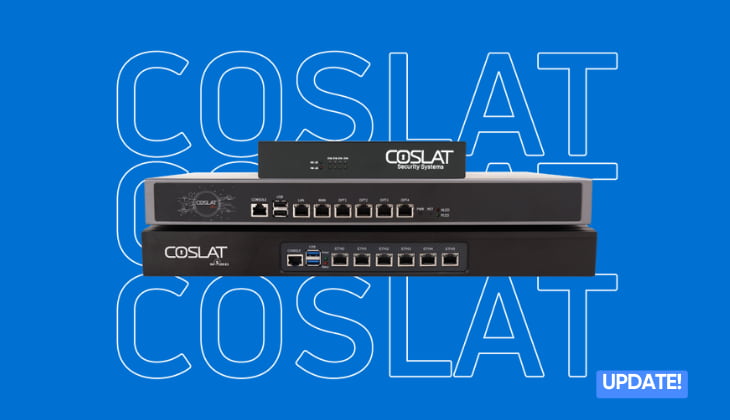
Breaking the Cyber Kill Chain with Coslat Firewall
Breaking the Cyber Kill Chain with Coslat Firewall
The Cyber Kill Chain model, developed by Lockheed Martin, outlines the steps a cyber attacker must take to reach their target.
This model shows us the phases an attacker goes through and provides insights into what measures can be taken at each stage. Additionally, since this model allows us to view our systems from an attacker's perspective, it helps us implement more effective security measures.

The Cyber Kill Chain model describes the attacker's path in seven steps, which can be summarized as follows:
- Reconnaissance: This is the first phase of the model, where extensive information about the target system is gathered. The goal is to identify weaknesses in the system.
- Weaponization: In this phase, the attacker uses the information gathered during reconnaissance to develop customized attack tools and malware tailored to the target system.
- Delivery: This process involves the attacker attempting to deliver the prepared malware or exploits to the target system. The attacker may use phishing, malicious websites, USB drives, Trojan horses, messaging, and social media applications to execute the attack.
- Exploitation: The attacker tries to exploit the vulnerabilities identified earlier to gain unauthorized access to the target system or activate the malware.
- Installation: After a successful exploitation, the malware is installed on the target. The attacker then tries to establish persistent access after a successful intrusion.
- Command and Control: The attacker establishes remote control over the compromised system, allowing them to manage and control the target remotely.
- Action on Objectives: The final and most critical step of a cyberattack, where the attacker accomplishes the actual goal of the attack, such as data theft, system sabotage, or extortion.
Completing all seven steps means the attacker has reached their target. To neutralize the attack, one of these steps must be broken before reaching the final stage. The impact and cost of stopping the attack increase with each step.
Breaking the Chain with Coslat Firewall
Coslat Firewall offers many options to break this attack chain through its layered architecture. Let's explore how Coslat Firewall can help break the chain at each attack stage:
Reconnaissance Phase:
- Advanced IP and Port Filtering: Helps restrict access by allowing limited permissions and filtering known malicious IPs and ports during IP and port scanning stages.
- Protocol Control: Limits access to specific protocols, reducing the attack surface.
- Integrated Intrusion Detection System /Intrusion Prevent System (IDS/IPS): Detects and prevents suspicious activities using advanced algorithms.
- Geolocation Filtering: Blocks traffic from specific regions, preventing targeted attacks.
Delivery:
- Advanced Application Filter (App Filter): Coslat Application Filter monitors, controls, and blocks specific application traffic as needed, restricting access to potentially harmful applications.
- Comprehensive Web Filtering: Identifies and blocks malicious websites and content through the Coslat Web filtering service, preventing web-based threats from infiltrating the network.
- SSL/TLS Inspection: Analyzes encrypted traffic to uncover hidden threats.
- Deep Packet Inspection (DPI): Analyzes network traffic in depth and detects anomalies.
- IP Spam Filter: Automatically blocks traffic from malicious sources.
Exploitation (Abuse):
- Integrated Antivirus Protection: Detects and neutralizes malware using advanced signature-based and behavioral analysis techniques.
- Authentication and Authorization: Prevents unauthorized access by enforcing identity verification in network traffic and utilizing 2FA in remote access to block unauthorized access.
- DNS Filtering and Security: Blocks access to unknown sources and prevents users from incorrect name resolutions.
- Integrated Intrusion Detection System /Intrusion Prevent System (IDS/IPS): Detects and prevents suspicious activities with advanced algorithms.
Installation:
- Secure Zone Creation: Creates a secure zone with restricted access for critical resources.
- Traffic Inspection and Alerts: Creates alerts for unwanted traffic and provides notifications.
- Integrated Antivirus Protection: Detects and neutralizes malware using advanced signature-based and behavioral analysis techniques.
Command and Control:
- Network Traffic Analysis: Continuously monitors network traffic to detect abnormal behavior.
- DNS Filtering: Blocks access to unknown sources and prevents users from incorrect name resolutions.
- URL Filtering: Cuts off communication with malicious servers.
- SSL/TLS Inspection: Analyzes encrypted traffic to detect anomalies in the system.
- Application Filtering: Allows the passage of specific applications and blocks unknown applications.
- Geolocation IP Filtering: Prevents traffic heading to suspicious locations.
- IDS/IPS and Anti-Spam: Blocks the attacker's communication with the target.
Action on Objectives:
- Advanced IP and Port Filtering: Limits access only to authorized targets, preventing data leakage.
- Integrated Intrusion Detection System /Intrusion Prevent System (IDS/IPS): Detects and automatically blocks abnormal and malicious activities in real-time.
- URL Filtering: Cuts off communication with malicious servers.
- SSL/TLS Inspection: Analyzes encrypted traffic with certificate loading to detect anomalies in the system.
- Application Filtering: Allows the passage of specific applications and blocks unknown applications.
- High Availability: Provides redundancy to prevent interruptions.
- Multi-WAN: Manages multiple lines for continuous connectivity.
- Behavioral Analysis: Identifies potential threats by detecting unusual user or system behavior.
Understanding the steps of a cyberattack is an effective way for an organization to be prepared against cyber threats. This allows taking the correct steps to prevent the attacker from reaching their goal.
We have seen how the path followed by the attacker in the Cyber Kill Chain model can be broken using Coslat Firewall.

